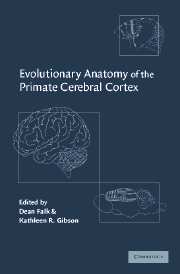Book contents
- Frontmatter
- Contents
- List of contributors
- Preface
- Prologue: Size matters and function counts
- Part I The evolution of brain size
- Part II Neurological substrates of species-specific adaptations
- Introduction to Part II
- 7 The discovery of cerebral diversity: an unwelcome scientific revolution
- 8 Pheromonal communication and socialization
- 9 Revisiting australopithecine visual striate cortex: newer data from chimpanzee and human brains suggest it could have been reduced during australopithecine times
- 10 Structural symmetries and asymmetries in human and chimpanzee brains
- 11 Language areas of the hominoid brain: a dynamic communicative shift on the upper east side planum
- 12 The promise and the peril in hominin brain evolution
- 13 Advances in the study of hominoid brain evolution: magnetic resonance imaging (MRI) and 3-D reconstruction
- 14 Exo-and endocranial morphometrics in mid-Pleistocene and modern humans
- Epilogue: The study of primate brain evolution: where do we go from here?
- Index
12 - The promise and the peril in hominin brain evolution
Published online by Cambridge University Press: 07 October 2011
- Frontmatter
- Contents
- List of contributors
- Preface
- Prologue: Size matters and function counts
- Part I The evolution of brain size
- Part II Neurological substrates of species-specific adaptations
- Introduction to Part II
- 7 The discovery of cerebral diversity: an unwelcome scientific revolution
- 8 Pheromonal communication and socialization
- 9 Revisiting australopithecine visual striate cortex: newer data from chimpanzee and human brains suggest it could have been reduced during australopithecine times
- 10 Structural symmetries and asymmetries in human and chimpanzee brains
- 11 Language areas of the hominoid brain: a dynamic communicative shift on the upper east side planum
- 12 The promise and the peril in hominin brain evolution
- 13 Advances in the study of hominoid brain evolution: magnetic resonance imaging (MRI) and 3-D reconstruction
- 14 Exo-and endocranial morphometrics in mid-Pleistocene and modern humans
- Epilogue: The study of primate brain evolution: where do we go from here?
- Index
Summary
There is always a temptation to treat an endocast as if it were a ‘fossil brain’, no matter how often one repeats the caveat that it is at most an impression of a brain on the skull. It is almost impossible to avoid this identification of an endocast with a brain when one analyzes endocasts for information about the evolution of the brain, but this rarely leads to serious problems in actual work with the endocasts.
Harry Jerison, 1973It is just over a quarter of a century since Harry Jerison published the first edition of his seminal work, Evolution of the Brain and Intelligence (1973). At the time and in the decades since then, we see it as one of the most significant paleo-neurobiological landmarks which heralded the final quarter of the twentieth century. As we enter the twenty-first century, that work remains ineluctably a signpost for the coming era. It is pleasurable indeed to offer homage to Dr Jerison – who was born one day before me in what seems to have been something of an annus mirabilis, 1925 – and to offer him my thanks for his inspiration and his friendship.
When we consider the ancient hominins, one is struck by the fact of how few have yielded good natural endocranial casts (endocasts).
- Type
- Chapter
- Information
- Evolutionary Anatomy of the Primate Cerebral Cortex , pp. 241 - 256Publisher: Cambridge University PressPrint publication year: 2001
- 1
- Cited by



